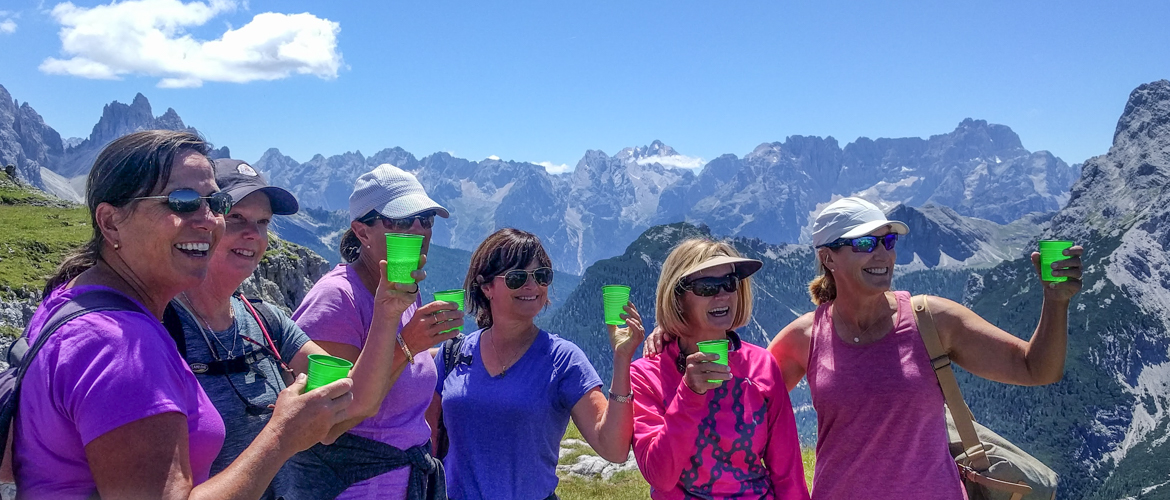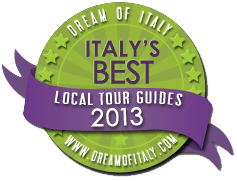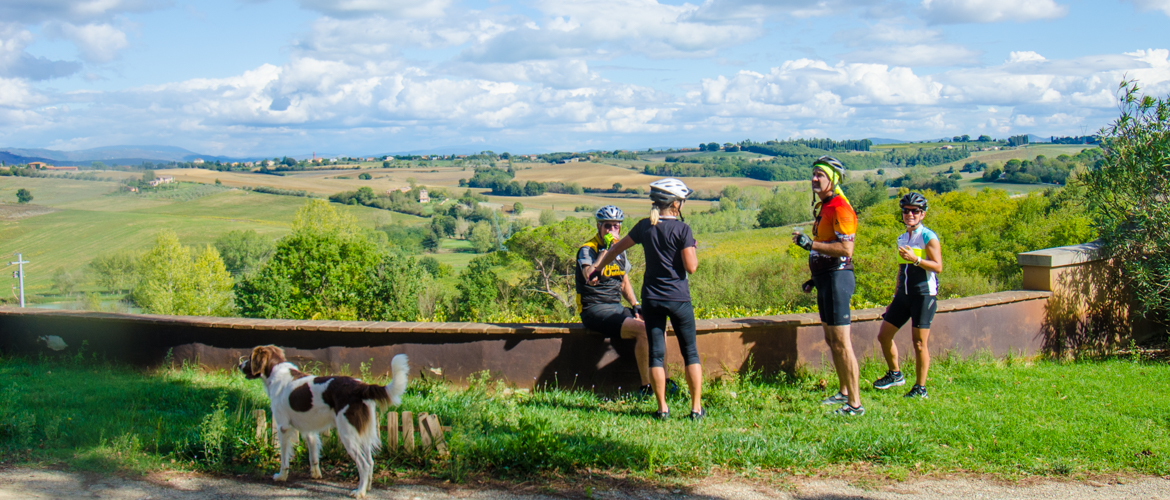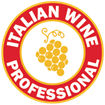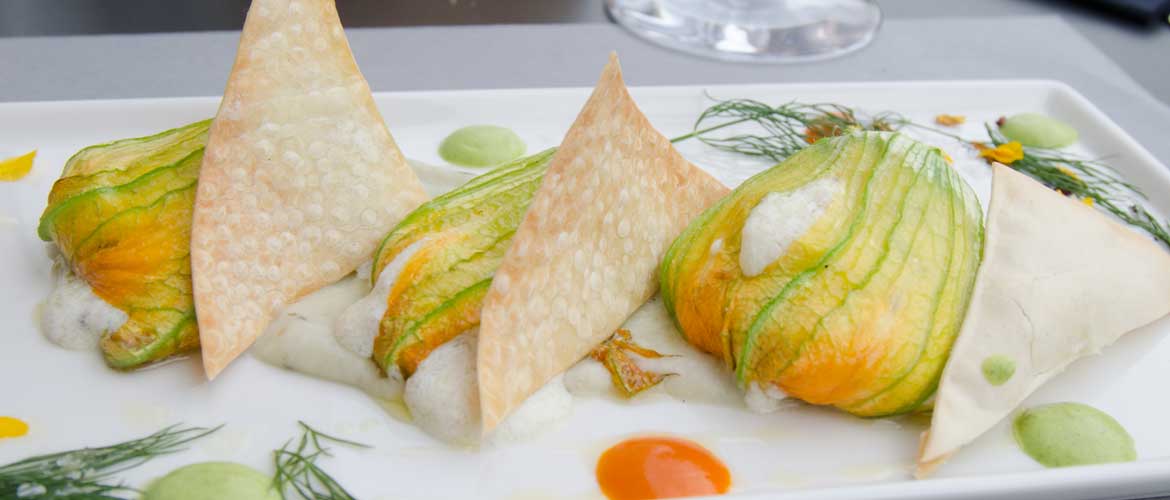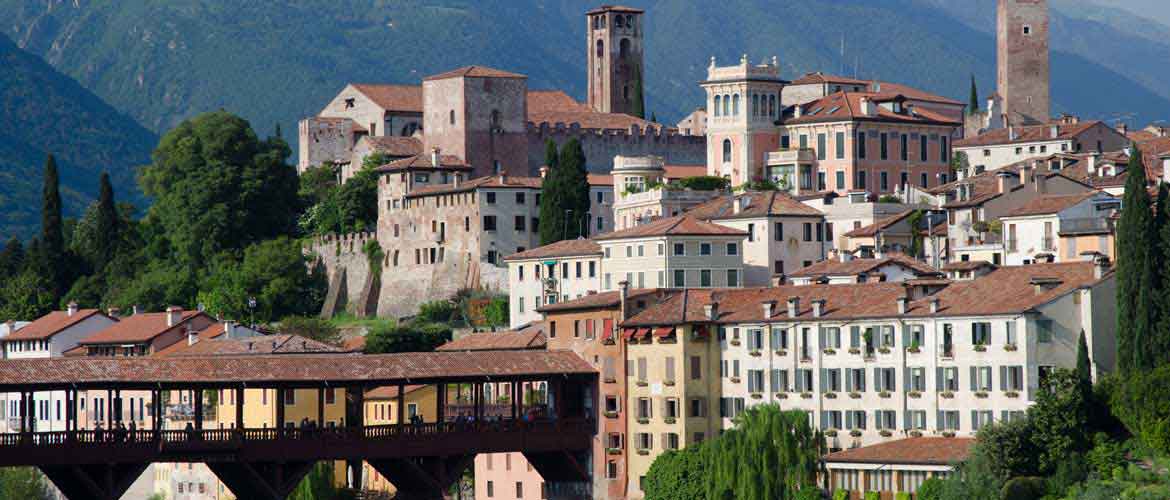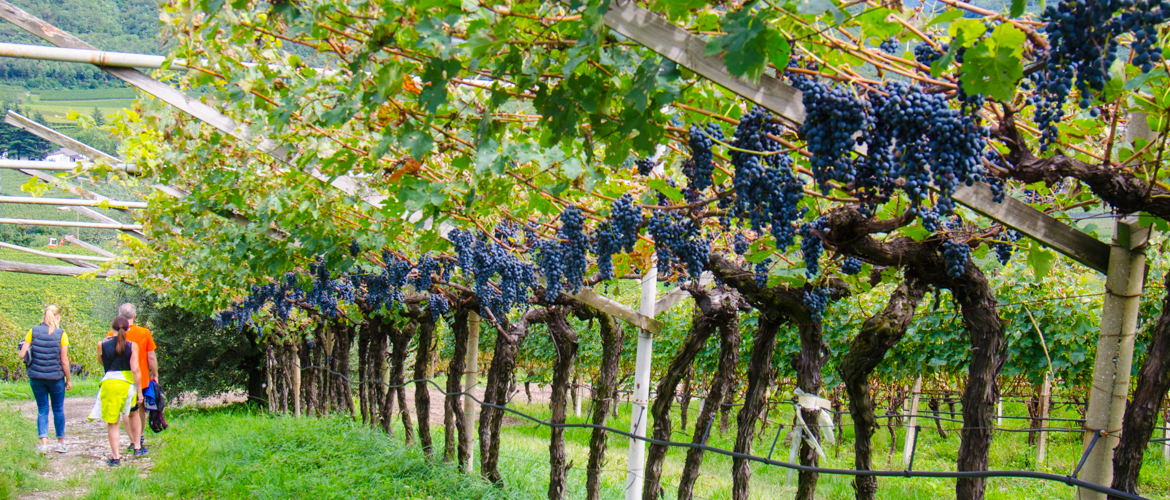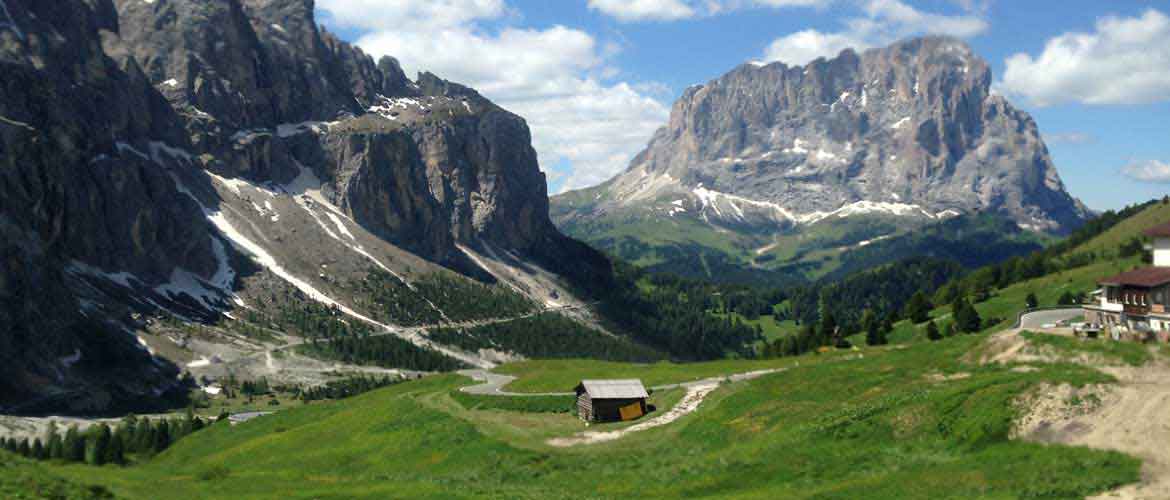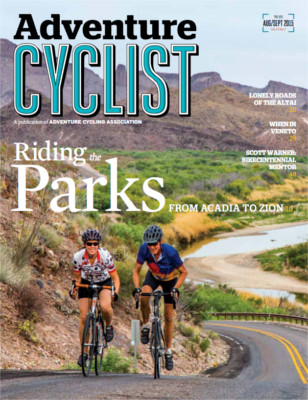Located in the northwest corner of Italy is the region of Piedmont. The second largest region in Italy, with its capital of Turin/Torino, Piedmont’s position between the sea to the south, France to the west, and Switzerland to the north, has positioned it as an important player in the transport of goods throughout history. These various influences have also had significant influence on the region’s unique cuisine.
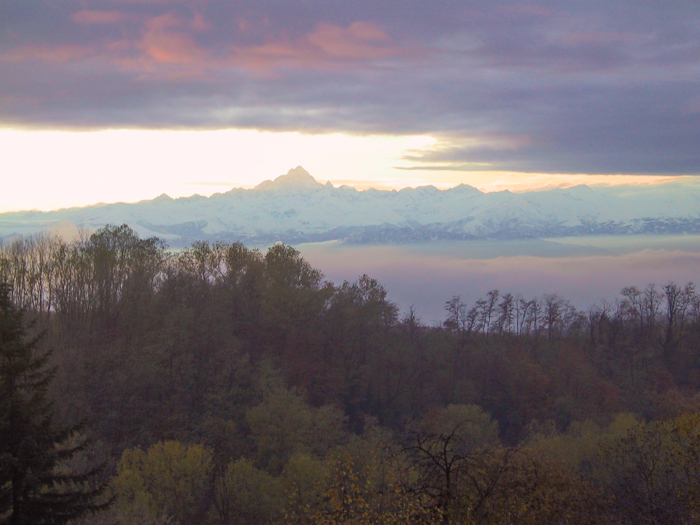
Along the western and northern borders, Piedmont is surrounded by the Alps, with over 40% of it’s terrain categorized as mountains. Moving east, the mountains transition to the lovely hills of the Langhe and Monferrato, dotted with vineyards produced the renowned wines of Piedmont, including Barolo and Barbaresco. The Po River, Italy’s longest river whose fertile food plain has fed northern Italy for centuries, begins in Piedmont under the shadow of Monviso in the Alps and crosses Piedmont, through Turin and opening into flat plains around Novara and Vercelli on the eastern border near the region of Lombardia. This diverse countryside provides an amazing range of products for the tables of Piedmont.
As Piedmont does not lie directly on the coast, the cuisine is predominately meat and dairy. Hunting and fishing is commonplace In the mountainous areas to the west; game like wild boar, as well as freshwater trout from mountain streams. As in the nearby region of Valle d’Aosta, many of the meat recipes come from across the Alps - hearty braised meat and mixed boiled meats, called bolliti, served with a variety of sauces.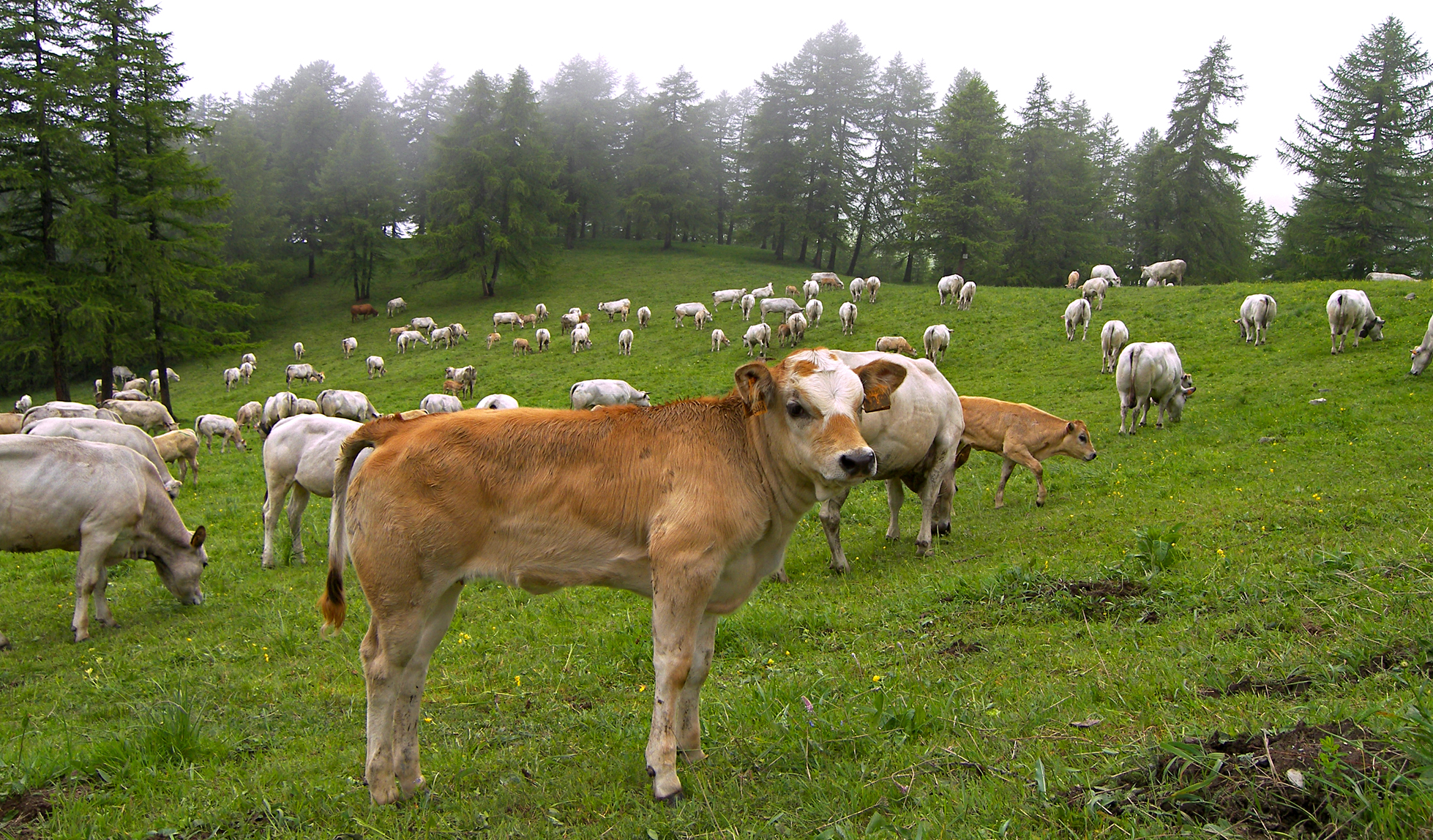
There is also traditional stock-rearing of cattle and pigs. Piedmont is known for it’s prized breed cattle, called “Razza bovine piemontese”. These are almost exclusively raised on smaller family farm which adhere to a high standard of breeding. In the 1870s, this breed began exhibiting a unique “double muscling” characteristic that resulted in beef with extra muscle mass and very little fat and low cholesterol content. In spite of the lack of marbling, this lean beef is tender and juicy, and often enjoyed raw in Carne Crudo.
Historically, in autumn people head into the forests and hills to collect mushrooms and nuts, which could be dried or roasted and used all year round. Today fall menus in Piedmont feature porcini mushrooms, hazelnuts and chestnuts.
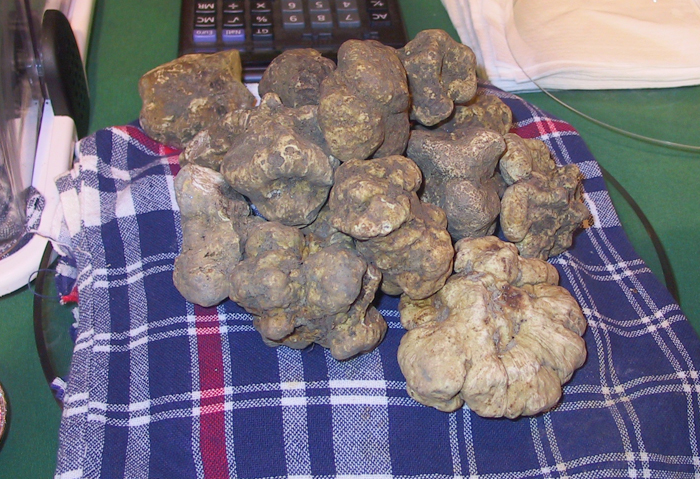
But probably the most precious autumn culinary treasure are the prized white truffles from Alba and Mondovì. These delicacies have distinctive pungent aromas and strong, earthy tastes. During autumn months they are hunted using pigs or white dogs, usually at night when their smell is at it strongest. They are typically served simply shaved over pasta, eggs, or risotto. White truffles can command prices close to $4000 a pound. For five weekends beginning in mid-October, truffle lovers from all over the world descend upon Alba to taste and buy their prized white truffle.
The influence of neighboring France and Switzerland is exhibited in Piedmont’s vast array of cheeses. From Taleggio, Ossolano d’Alpe, also called Bettelmatt, to Castelmagno, Robiola di Roccaverano, Bruss, and Murazzano, nine of the over 40 Italian DOP cheeses hail from Piedmont.
The river valleys of Piedmont supply fruits, vegetables and grains to the region, not only the Po River but smaller tributaries like the Tanaro, Belbo, and Bormida. Fruit orchards dot the hillsides alongside neatly terraced vineyards. In the spring, the Saracen asparagus from Vinchio is cultivated in the hills between vines. Summer brings red and yellow peppers, known as "Quadrato d’Asti”, which are enjoyed raw with bagna cauda, or preserved in oil.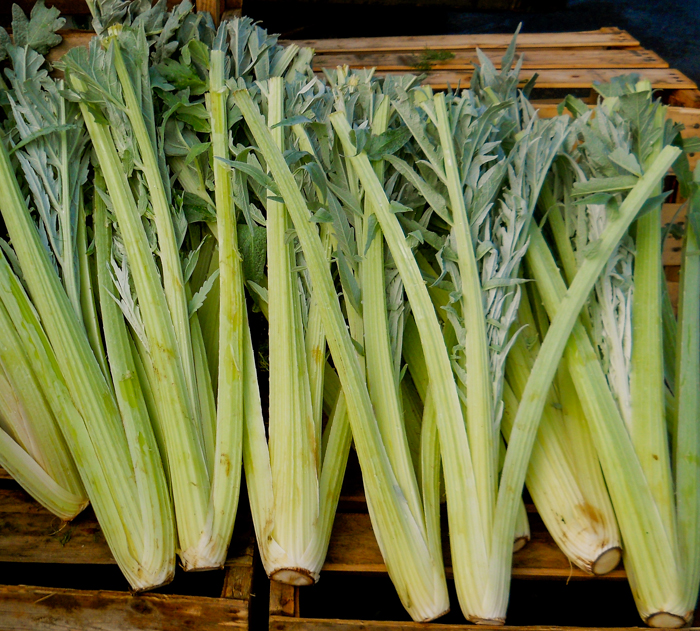
In autumn you will find a unique vegetable not common in the US, the cardoon. Locally called cardo gobbo, or “hunchbacked” cardoon, it is a white crunchy stalk, with a sweet flavor similar to an artichoke. It is an essential ingredient to an autumn bagna cauda. or cooked in a bechemel.
Rice and corn flourish in the fertile Po river valley the provinces of Novara and Vercelli. So you will find many types of risotto and polenta on the tables of Piedmont. Gnocchi and pasta are common here as well, the hand-made local pasta include tagliatelle, here called tajarin, as well as a stuffed ravioli type pasta, here called agnolotti dei plin (pinched). Piemontese pasta is characterized by the use of only egg yolks, sometimes up to 30 yolks per kilo of flour. Great fresh yolks from truly free range chickens are bright orange in color, and I will always recall the deep vibrant hue of the first plate of agnolotti I enjoyed in Piedmont.
Desserts are dominated in Piedmont by two well known products: chocolate and hazelnuts. Piedmont has given us gianduja, a Piemontese specialty of chocolate-hazelnut cream, and, of course, Nutella. Turin has been known for chocolate production as far back as the sixteenth century, today home to candy producers Caffarel and Ferrero Rocher.
Regional dishes of Piedmont:
Antipasti:
Grissini - Long thin breadsticks, often referred to in Piedmont as torinesi. Traditionally made by hand and mixed with water only, believed to be ease digestion.
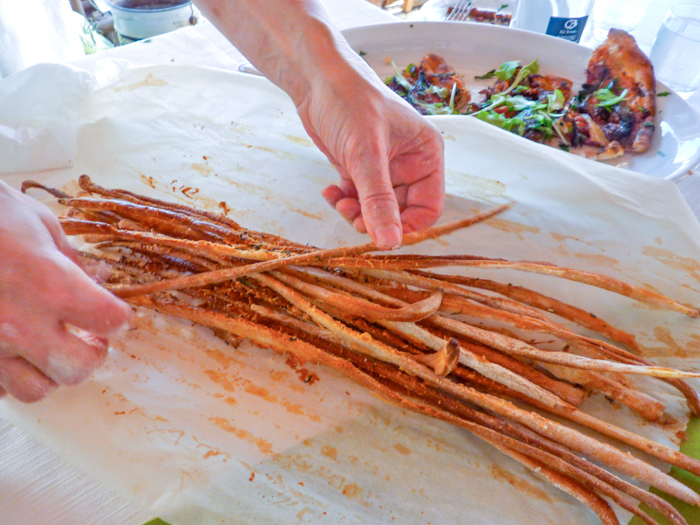
Carne cruda - Thinly sliced veal carpaccio or ground, from the locally raised Piedmont cattle. Mixed with olive oil, fresh garlic, lemon juice, and salt and pepper; put over the top when topped with white truffle shavings.
Vitello Tonnato - Thinly sliced veal served with a sauce of tuna, mayonnaise and capers. Served cold.
Bagna Càuda - Translates to ‘hot bath’, a community dish similar to fondue, with raw and cooked vegetables dipped into a sauce made of garlic, anchovies and olive oil which is kept warm over an open flame. A staple of the region, at one time this dish kicked off almost every Piemontese meal.
Cheeses:
Castelmagno - A semi-hard cheese produced from the whole cows of the Piemontese cattle which have been fed on fresh hay from pastures, then is aged in caves for two to five months. Fantastic on its own as a table cheese, used in fondues or enjoyed with risotto, pasta, or polenta. 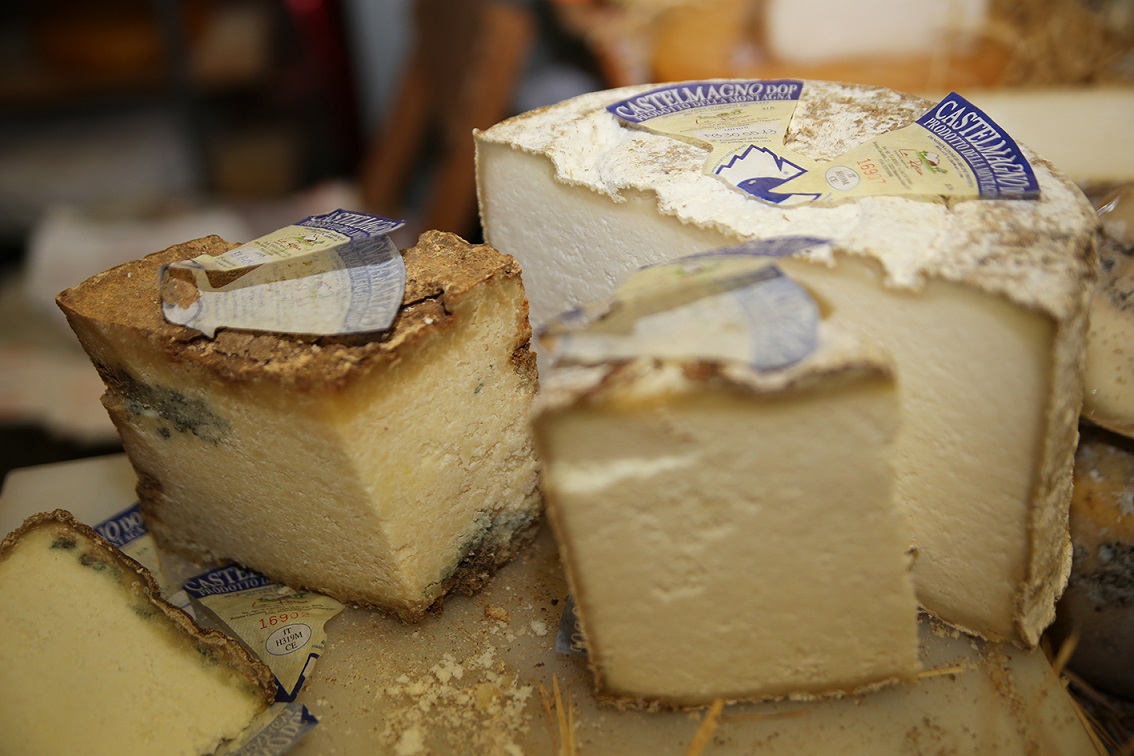
Robiola di Roccaverano - A soft-ripened cheese from the Langhe region and made with varying proportions of cow’s, goat’s milk and sheep milk. Robiola di Roccaverano has no rind and a slightly straw-yellow coloring with a sweet, mild taste.
Raschera - A pressed semi-hard cheese made with partly skimmed cow milk, to which a small amount of sheep's and/or goat's milk may be added. Ivory white color with irregularly spaced small eyes, and a semi-hard red grey rind. Savory and salty in taste, similar to Muenster cheese, becoming increasingly sharp with aging.
Toma Piedmontese - A soft or semi-hard cow's milk cheese. Toma varies with producer, region and locale of production, and is closely related to the French tomme.
Salumi:
Bale d’Aso - Traditionally made with donkey, this round sausage is today a mix of pork and beef seasonings. Boiled and served with masehed potatoes, beans or polenta.
Salsicca di Bra - A small salumi mad from raw ground veal mixed with pork fat, salt, pepper, nutmeg and cinnamon. In 1867 a royal decree banned the production of all veal sausages but the Bra style.
Cotechino - A fresh sausage made from pork, fatback, and pork rind. Also often served with lentils or beans and mashed potatoes or polenta.
Rice, Pasta, Polenta:
Tajarin - Long, thin ribbon-like pasta, similar to tagliatelle. Tajarin is a golden yellow-orange color from the rich farmhouse egg yolks used. An early recipe is said to require 30 egg yolks and over two pounds (just under a kilo) of flour. The pasta is cut into 1/8 to 1/4-inches wide strands. It is traditionally served with a meat ragu, mushroom ragu, or with a butter and sage mixture. During the late autumn and winter the butter and sage version may be topped with white truffle shavings.
Agnolotti del plin - Small, hand-made ravioli stuffed with minced meat, cheese, and/or vegetables and topped with either a meat ragu or butter, sage and nutmeg. Plin means ‘pinch’, as the pasta is pinched together during assembly.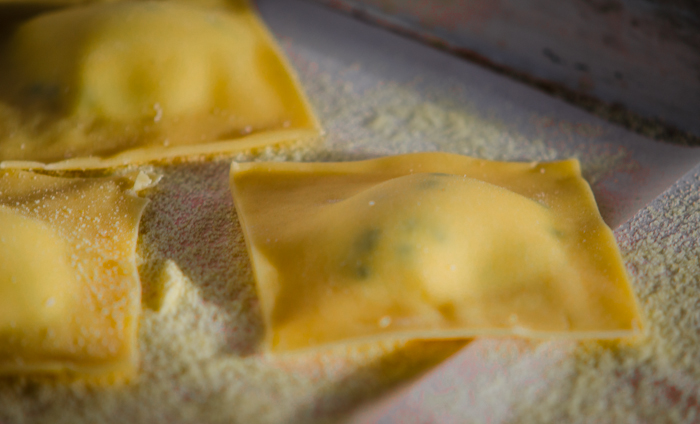
Risotto al Nebbiolo - Risotto made with local Nebbiolo-based wine like Barolo or Barbaresco.
Gnocchi della Val Varaita - A long football shaped dumpling made from potatoes and cheese. Served with butter and grated grana cheese.
Meat and Fish:
Bollito Misto - Mixed “boiled meats”. More of an event rather than a dish, this was served to a large group at a celebration. Traditionally this included seven or more cuts of meat, including beef, veal, chicken, sausage, and cuts like veal testina (head), hearts and tongue. The warm boiled meats were served with several spicy sauces, like a green sauce made with parsley, capers and anchovies and a red sauce made with tomatoes and peppers.
Fried eggs with shaved white truffle - A very simple dish, one of the best ways to enjoy the amazing white truffles of Piedmont. Fresh farmhouse eggs, scrambled, fried or poached, topped with shaved truffles.
Brasato al Barolo / Brasato al Barbaresco - Veal roast, marinated overnight in Nebbiolo, then braised till tender in herbs and vegetables and served with Barolo or Barbaresco.
Finanziera - A traditional dish, not for the faint of heart. It translates to “Food for financiers”. A stew of sweetbreads and offal such as veal spinal cords, brains, bull testicles, chicken feet, and cockscombs cooked in Nebbiolo wine. Another example of Italy’s ‘cucina povera’, peasant food utilizing every part of the animal.
Coniglio al Civet - A strongly seasoned stew of game (rabbit, hare, boar can all be used) cooked with red wine, rosemary and garlic.
Desserts:
Torta di Nocciola - A traditional cake made with roasted hazelnuts. Often accompanied by a sweet zabaione sauce, and paired with dessert wines like the regional frizzante white wine of Moscato d’Asti, or even reds like Barolo and Barbaresco.
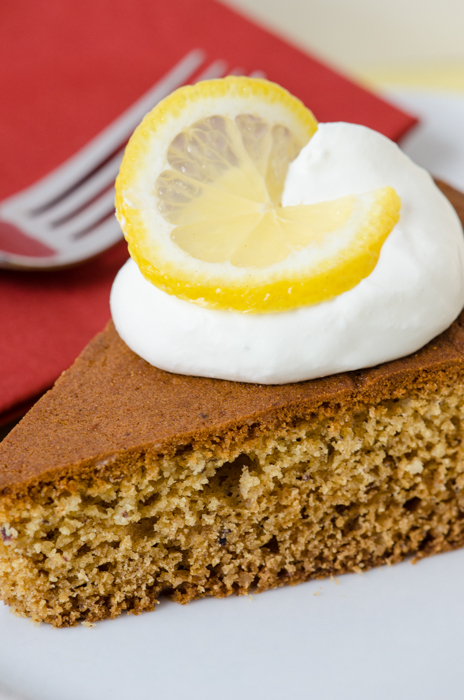
Bunet - A flan made with chocolate and amaretti. The word “bonet” translates to hat, and refers to the rounded shape of this cake.
Gianduja - A sweet spread of chocolate and hazelnut paste, invented in Turin during Napoléon's regency (1796–1814), when the Mediterranean was under a blockade by the British. Michele Prochet, a local chocolatier extended the little chocolate he had by mixing it with ground hazelnuts from the Langhe hills just south of the city.
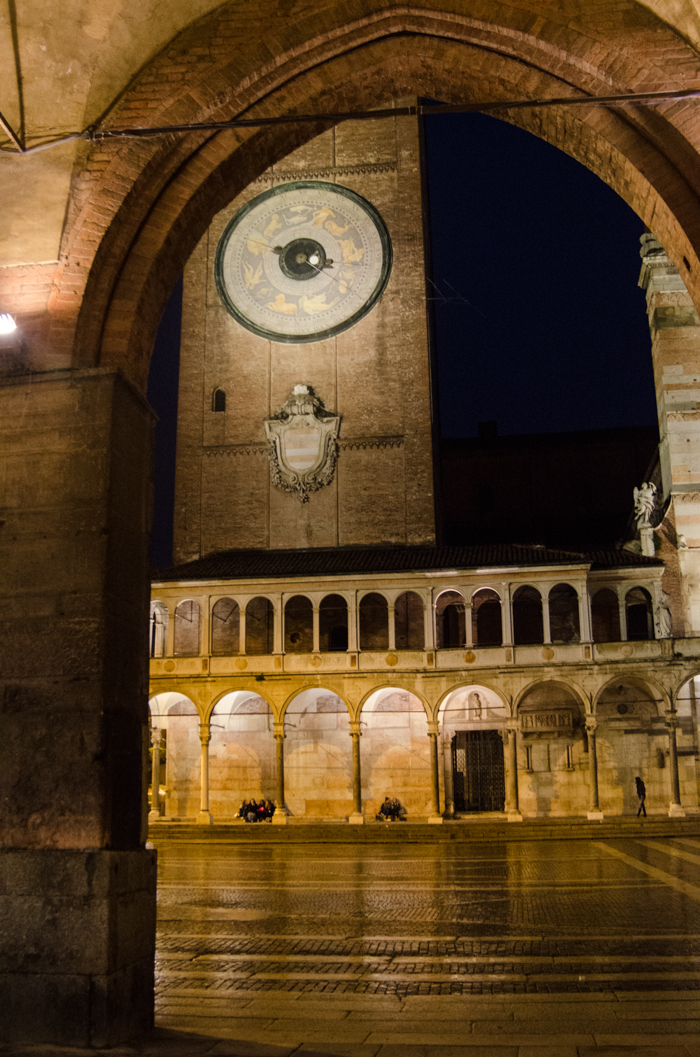
The region of Lombardia lies in northern Italy, sharing a border with Switzerland to the north, Piedmont to the west, the Veneto and Trentino-Alto Adige to the east, and Emilia-Romagna to the south. It is the largest region in the country, and Italy’s most productive farming region. It hosts a wide range of landscapes - from the Alps where we can visit Bormio on a Italy ski tour in the winter or a cycling tour of Stelvio in the summer, to the lake region - Como, Maggiore, Iseo and the western side of Lake Garda, to the fertile plains of the Po River valley. As with the other regions in Northern Italy, Lombard cuisine has more in common with that of Austria and central Europe than the cuisine of Central and Southern Italy - more emphasis on grains like rice and corn than pasta, and the use of butter, cream and cheese rather than olive oil (although olive oil is produced here too).
The Po River, the longest river in Italy, flows eastward towards the Adriatic through the southern portion of Lombardia. Several of its tributaries - Ticino, Adda, Oglio, Mincio - flow south from the lakes to the Po as it travels across the region.The fertile plains of the Po primarily produce grains, most importantly the rice for the regions most famous dish, risotto alla Milanese, cultivated in the Lomellina plains near Pavia. Other grains cultivated here include corn, used for polenta, and buckwheat, found in some versions of polenta (polenta taragna), and pizzoccheri, a buckwheat pasta.
The plains are also an ideal location to raise cattle, so veal and beef have always been an important part of Lombardia cuisine. Costalleta alla milanese (veal cutlets, breaded and sauteed in butter), osso bucco (braised veal shanks) and lesso misto, the Lombard version of bollito misto (mixed boiled meats) are a few of the traditional meat dishes found here. The area of Valtellina, way up north in the mountains is known for its Bresaola (air-dried salted beef). Lots of cows means lots of milk, which finds its way into many flavorful local cheeses, including Robiola, Crescenza, Taleggio, Gorgonzola and Grana Padano. Lodi is famous for a variety of cheeses, including Grana and mascarpone.
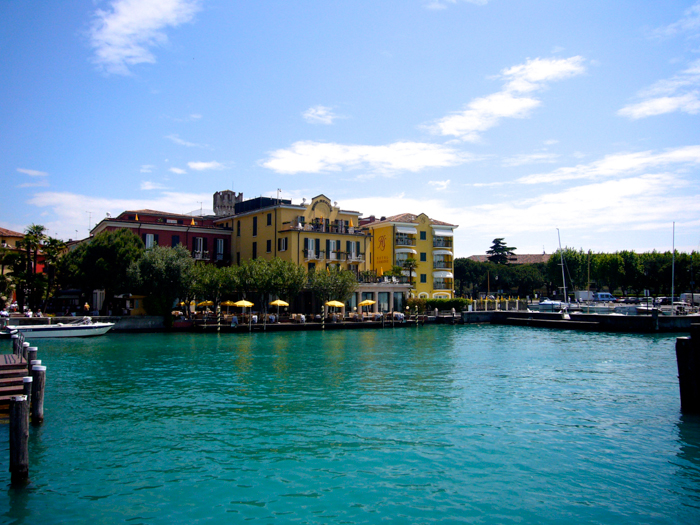
As it has no ocean coastline, the cuisine of Lombardia doesn’t typically use seafood, but the four lakes found here do supply a nice array of freshwater fish, often cooked simply, grilled or fried. Mountain streams flowing down from the Alps are a great source of trout. You will also find frogs, freshwater eels, crayfish and snails. Here in the lake districts you will also find locally produced olive oil.
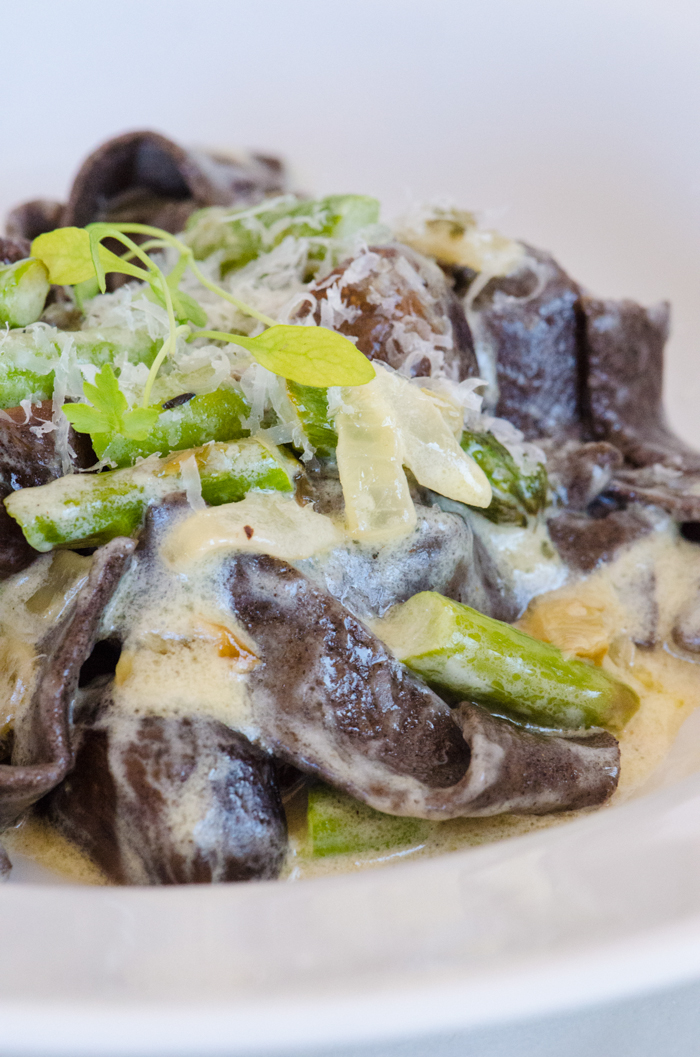
Moving north into the mountains, the climate is cooler, and the food heartier. Stews, soups, polenta served with meat or mushrooms, hearty filled raviolis and slow-braised meat dishes are favorites here. In spite of the prevalence of polenta and risottos over pasta, there are some specialty pastas made here - in addition to the pizzoccheri mentioned earlier, you will find a variety of stuffed pastas, including tortelli de zucca (made with winter squash, cheese and finely crushed amaretti almond cookies), agnolini (a smaller stuffed pasta, filled with a mixture of meats), and casônsei (filled with sausage, cheese, and bread).
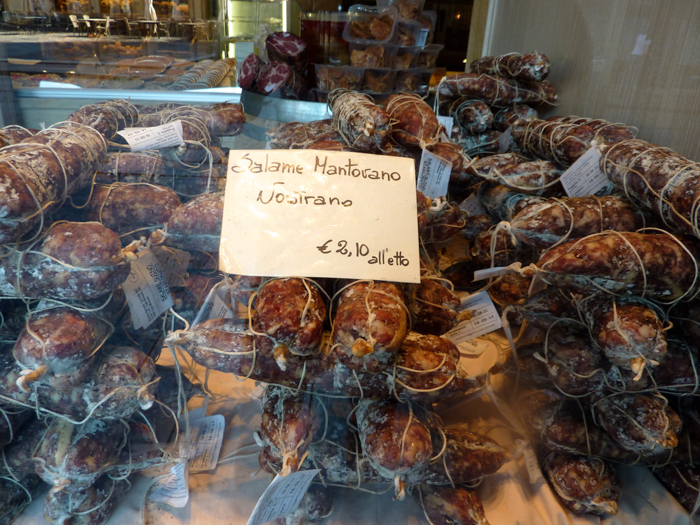
Pork is also used in many dishes. We find many local produced salume here, like mortadella and cotechino. A nice way of warming up after a ski day is with a cassoeula, a hearty stew of cabbage and pork, served with polenta.
Every region has its favorite dolce to finish off a meal, and Lombardia is no exception. It is most famous as the creator of Italy’s favorite Christmas treat, Pannetone - a sweet, eggy raised bread with raisins and candied citrus. There is also torta sbrisulona, a crisp, buttery almond cake using the local polenta. Cremona produces Torrone, a nougat made from almonds and egg whites, sweetened with honey.
As with most other regions in Italy, there is wide variety of dishes found on the tables across Lombardia, with each city and province offering its own traditional specialties. Here is just a sampling:
Minestrone alla Milanese - vegetable soup, which here in Lombardia would include rice rather than pasta.
Zuppa alla Pavese - hot beef consomme, poured over bread and an egg yolk, which cooks (a little) in the hot broth.
Risotto alla Milanese - risotto with saffron. The year 1535 began 200 years of Spanish rule in Milan, when King Charles V made his son Philip the Duke of Milan. So risotto alla milanese is the local take on paella.
Casoncelli - a stuffed pasta from Bergamo. Filled with meats, cheese, and sometimes even dried fruit and crushed amaretti cookies, served with melted butter, pancetta and sage.
Polenta taragna - a specialty of the Valtellina valley, made from buckwheat with a bit of cornmeal. Traditionally left to harden, then served sliced with melted butter and cheese.
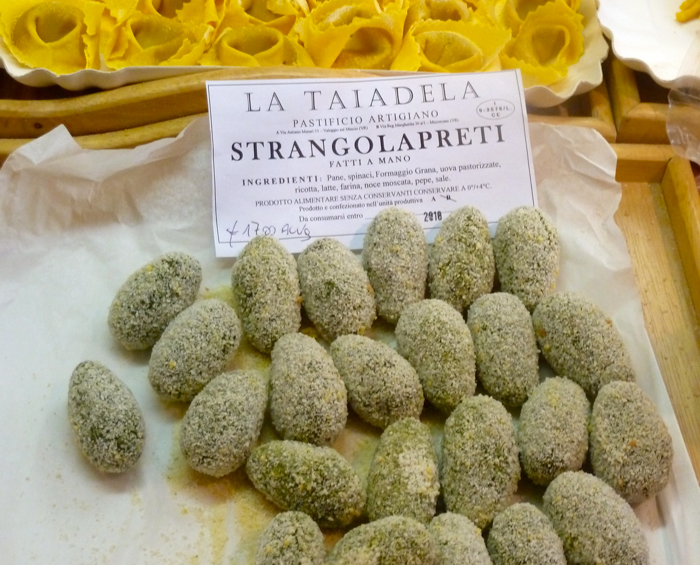
Strangolapreti - spinach gnocchi, translates to “priest stranglers”, as priests supposedly would gorge themselves on these meat-free dumplings during Lent.
Riso alla pitocca - literally translates to ‘beggar’s rice’, it really isn’t, as it includes a meat, chicken.
Polenta pasticciata - polenta pie, layers of firm polenta alternating with butter and cheese, sometimes also meats and mushrooms, baked in the oven.
Pizzoccheri - flat pasta, made with buckwheat and wheat flour, served with potatoes and beans’
Tortelli di zucca - ravioli with pumpkin filling, served with butter and sage. Very similar to cappellacci di zucca, from nearby Ferrara.
Casônsei - similar in name to the casunziei found in Cortina, this stuffed pasta is from Brescia, and contains sausage, cheese, and bread crumbs.
Cotoletta alla Milanese - breaded veal chops, sauteed in butter; this dish travelled to Vienna when Austria ruled this region, becoming Wiener Schnitzel.
Osso Buco alla Milanese - braised veal shanks, seasoned with gremolada, a combination of lemon zest, garlic and fresh parsley. Usually served with risotto alla Milanese.
Lesso Misto - several types of meat, boiled together. Here, they used better cuts of meat than in bollito misto, and a mix - beef, chicken, pork. Served with mostarda di Cremona.
Busecca - tripe cooked very slowly with herbs and vegetables, served with over bread with grated grana.
Cassoeula - a pork stew, containing various cuts of pork, pig’s foot, crackling and sausage, stewed with cabage, carrots, celery and onions. There are also versions with goose.
Stufato - beef chunks, stewed slowly with white wine, tomatoes, carrots and celery. Many traditional versions exist using donkey (stufato d’asino) or horse (stufato di cavallo).
Fritture di rane - fried frogs, frogs being a by-product of flooded rice fields.
Panettone - an egg based, yeast leavened cake with raisins and candied citrus, traditionally served at Christmas.
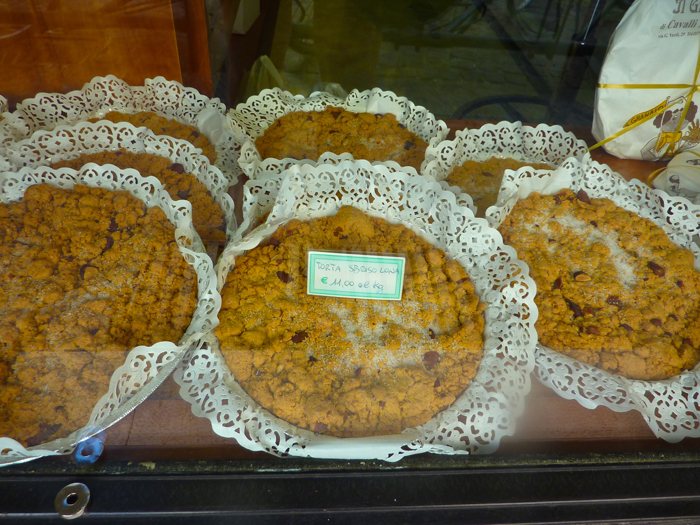
Sbrisulona - a crumbly cake made from white flour, polenta, butter, sugar and almonds.
Mostarda - from Cremona. A mixture of fruits, preserved in a sugar syrup, flavored with mustard oil and other seasonings. Traditional accompaniment to Lesso misto.
Torrone - a nougat made from egg whites, sugar, honey, toasted almonds and candied fruit.
Colomba di Pasqua - a traditional Easter cake, shaped like a dove (“Colomba”). Similar in type to a Panettone, without the raisins and candied citrus.
Umbria has been proclaimed il cuor verde d'Italia - the green heart of Italy. Located in the geographic center of the Italian peninsula, it is the only region in the country that does not posses either a coastline or border with another country. The cuisine of Umbria is beautifully simple and plain, replete with fresh local seasonal produce, such as such as peas, tomatoes, potatoes, onions, beans, spinach and eggplant.
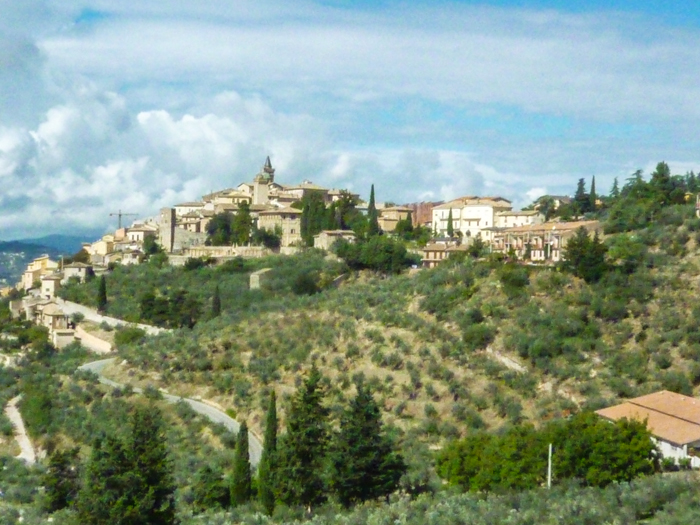
As in the rest of Italy, seasonality plays a huge role in Umbrian cuisine, as the poorer families in the region forage for what they can find. In the spring, locals will park their cars by the side of the road and head in to a favorite spot in the woods to find wild asparagus. Summer brings plenty of delicious, juicy blackberries. Fall brings wild mushrooms to the table - all of these you can find for sale at the local markets, if foraging yourself seems a bit daunting!
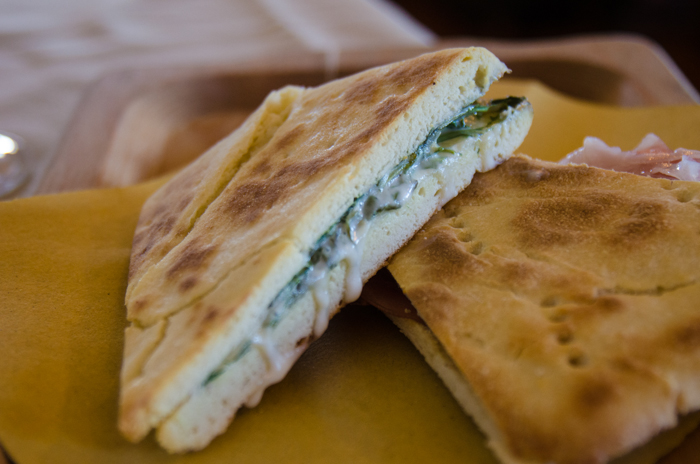
While landlocked, fertile farmland abounds along the many tributaries of the Tiber that flow through Umbria. Grains like wheat and farro and pearl barley are cultivated, and find their way into breads, soups and salads. One of the most popular bread in Umbria is torta al testo, a flatbread cooked on a round metal or stone griddle, called a testo. It can be served stuffed with grilled sausages, prosciutto, cooked greens, or cheese, or simply plain, as a bread to accompany a meal.
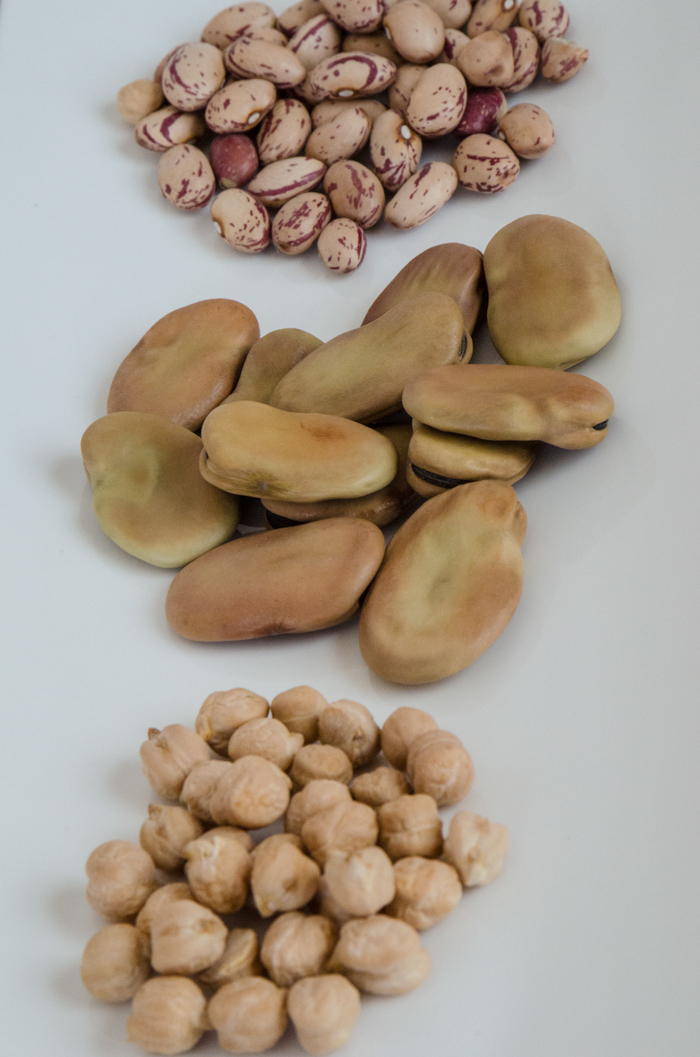
Umbria is particularly well known for its beans and lentils, which are dried and appear on their table year round. Some very special heirloom varieties include Roveja di Civita di Cascia, small wild peas that grow high on the slopes of the Sibillini mountains, and the Lake Trasimeno bean, a tiny bean about the size of a grain of rice, which are eaten both dried and fresh. Also from Lake Trasimeno is the fagiolino, a eyeless type of black-eyed pea, Cave di Foligno’s rare variety of navy bean, the fagiolo or the earthy cicerchie, a type of chickpea. The town of Castelluccio produces some wonderful tiny lentils.
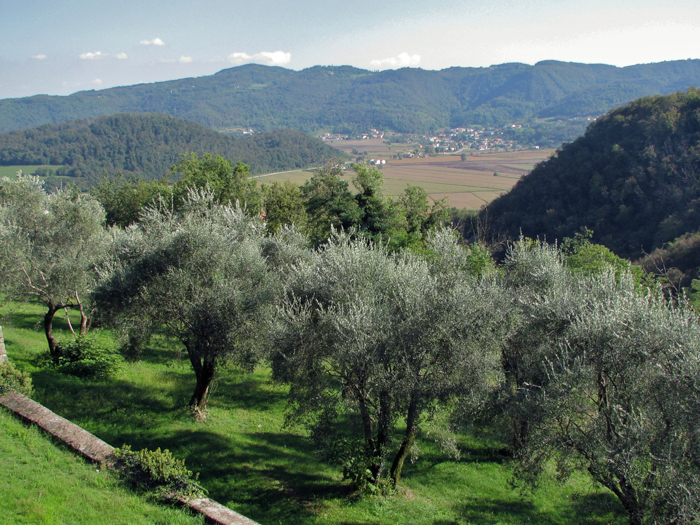
Late fall brings the olive harvest to the hillsides of Umbria. Olives are hand-picked, by workers on wooden ladders, and dropped into baskets or nets spread on the ground under the trees. Locals bring their olives to olive oil mills, where the olives are pressed, the oil filtered and bottled. A drizzle of olive oil will finish soups, salads, and meats, with Umbrians very particular about what type of olive oil accompanies a dish. Umbria boasts no less than five different DOP denomination varieties: Colli Orvietani, Colli Martani, Colli Amerini, Colli di Assisi-Spoleto, Colli del Trasimeno. Umbria’s largest production center for olive oil is Trevi, surrounded by mountainsides covered with olive trees.
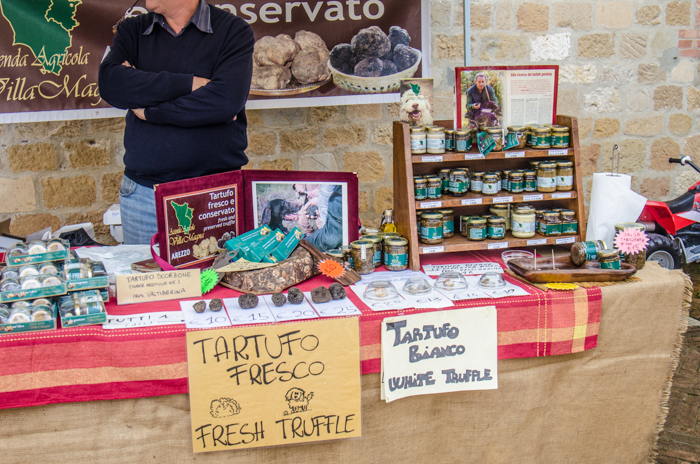
Fall also brings the most luxurious of Umbrian specialities - the truffle. Both black and white truffles are found in the region. These misshapen, unassuming fungi are found all year round. White truffles, rarer and more aromatic, are more highly prized than the black summer truffles. Close to half (45%) of all black truffles produced in Italy hail from the area around Valnerina. There are three main truffle fairs in Umbria each winter, in Norcia, Valtopina, and Città di Castello. You will find truffles grated over pasta, flavoring pates, sauces, and frittatas.
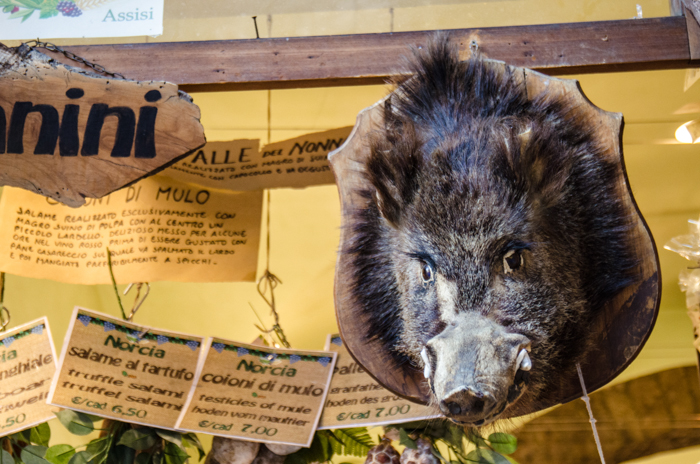
Over the centuries, small Umbrian family farms located on the hillsides favored the raising of pigs over beef. To preserve the meat for consumption year round, the Umbrians became masters of curing meats into a wide array of salame, prosciutto, pancetta, and dried sausages. The ancient town of Norcia is the center for the production of cured meats in the region, so much so that the term norcino in Italian indicates all types of preserved meats. Try the distinctive Prosciutto di Norcia, with it’s DOP quality designation, made from pigs that have been fed a diet of acorns. There is capocollo, a spicy local sausage flavored with garlic and peppers, and ciauscolo, made from pork shoulder, belly and pork fat all minced three times and ideal for spreading over bread. Mazzafegato is made from the leftovers of a pig after other cured meats have been prepared, where the fegato (liver) and any other leftover meat is coarsely minced and cured with salt, pepper, small amounts of garlic, lemon and/or orange peel and, in particular, fennel flowers
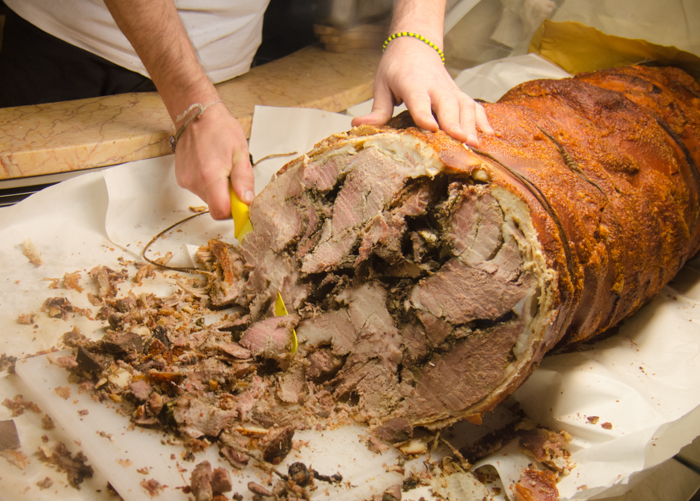
No visit to an Umbrian market is complete without a visit to a porchettai - a food truck serving the wonderful roast pork sandwiches, porchetta. This pork is made from an entire pig which has been deboned, stuffed with garlic and herbs such as rosemary and fennel, then spit roasted over a wood fire.
In spite of it’s landlocked location, fish does appear on the tables of Umbria, freshwater species from Lake Trasimino. Tench, carp, pike, perch, and eel are just a few of the varieties of fish you can sample during your visit.
Umbria also has a long history of chocolate production. The Perugina chocolate company was founded in 1907 in the city of Perugia. It rose to international fame with Baci, made with dark chocolate and hazelnuts. Initially named cazzotti, Baci were renamed by the dissolute Italian poet Gabriele D’Annunzio. You can visit the Perugina museum, devoted to the history of the company, and view the original machinery used to produce the chocolates. In 1988 Perugina was incorporated into the Swiss multinational Nestlé.
In Italy, the Traditional Speciality Guaranteed (TSG) quality designation refers to an agricultural product or foodstuff produced either using traditional raw materials or characterized by a traditional composition or a mode of production and/or processing reflecting a traditional type of production and/or processing.
In Umbria, there are 70 TSG products. This list has been assembled by the Strade dei Sapori in Umbria committee.
Fresh meat (and offal) and preparation thereof:
Capocollo (salted and smoked pork meat taken from the neck)
Coglioni di mulo
Coppa di testa (seasoned pork shoulder)
Corallina or salame umbro (Umbrian salami)
Guanciale or barbozzo (a sort of Italian "bacon" made from the pig's cheek)
Lombetto
Mazzafegati
Porchetta (oven or spit roasted suckling pig flavoured with seasonings)
Prosciutto nostrano (ham)
Salame di Norcia (Norcia salami)
Salsicce (sausages)
Sanguinaccio (black pudding)
Ventresca
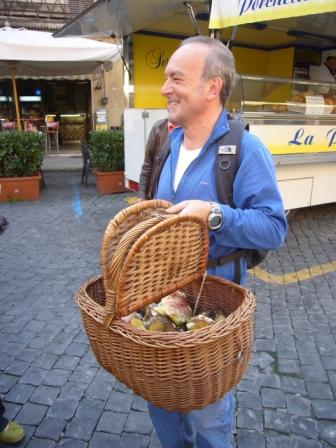
Condiments:
Pasta di olive (olive paste)
Paté di interiora di pollo (chicken entrails paté)
Cheeses:
Caciotta (caciotta and truffle caciotta)
Formaggio (farcito e misto)
Pecorino (di Norcia, di Norcia del pastore, stagionato in fossa/grotta, stagionato in botte, umbro)
Raviggiolo
Ricotta salata (salt ricotta)
Natural or processed plants products:
Broccoletti del lago (small broccoli of the lake)
Cicerchia
Cipolla di Cannara (Cannara onion)
Fagiolina del lago (Lake Trasimeno Bean)
Fagiolo di Cave (Cave Bean)
Farro (farro and farro di Monteleone) (spelt)
Lenticchie (lentils)
Marrone (sweet chestnut)
Patata rossa di Colfiorito (Colfiorito red potato)
Sedano nero di Trevi (Trevi black celery)
Tartufo bianco pregiato (fine white truffle)
Tartufo nero pregiato (fine black truffle)
Zafferano di Cascia (Cascia saffron)
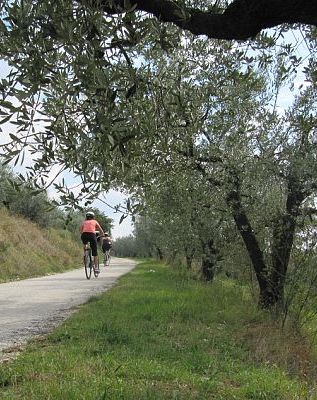
Fresh pasta, baked goods, biscuits, pastries and confectionery:
Attorta
Bringoli
Brustengolo
Castagnole
Ciaramicola
Ciriole
Cresciole di ciccioli
Crescionda
Fave dei morti
Mostaccioli
Nociata
Pammelati
Pampepato
Pan mostato
Pan nociato
Pane di Strettura
Passatelli
Pici
Pinoccate
Pinolate
Rocciata
Schiacciata al formaggio
Stinchetti
Strangozzi
Strufoli
Torciglione
Torcolo di S. Costanzo
Torta al formaggio o di Pasqua
Torta al testo
Tozzetti
Umbricelli
Fish, mollusks and shellfish dishes:
Anguilla (eel)
Carpa (carp)
Latterino (atherine)
Luccio (pike)
Persico reale (real perch)
Tinca (tench)
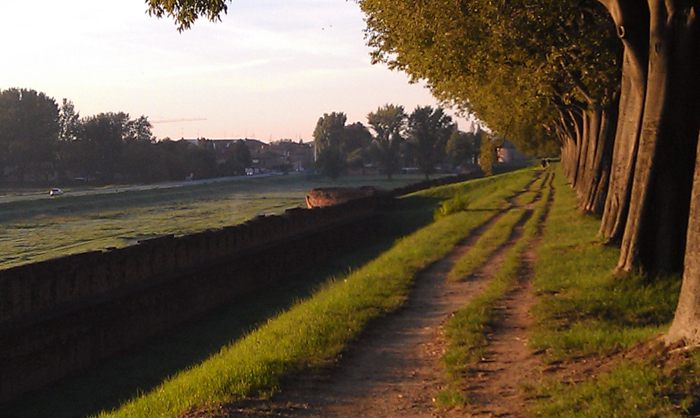
Nestled between the Veneto and Lombardia to the north, and Tuscany to the south, the region of Emilia-Romagna is not well-know to many visitors. The cities of Bologna, Ferrara, and Rimini are often overlooked by tourists traveling between Venice and Florence, but these cities have long histories as well, since 187 B.C. when the Romans built Via Emilia to connect with the cities of Venice and central and northern Europe. Along this north/south road, powerful families ruled the towns; the Este family in Ferrara, the Malatesta’s in Rimini, the Bentivoglios in Bologna. Bologna is also the site of the oldest university in the western world. The wealthy academics and royalty indulged in the best in food and wine; day long feasts were commonplace amongst the ruling classes, as one family tried to outdo the other. Bologna itself is known as the home of “la dotta, la grassa e la rossa”, the learned, the fat, and the red - the latter referring to the red hue of the majority of Bologna’s buildings as well as the popularity of the Communist party in this city.
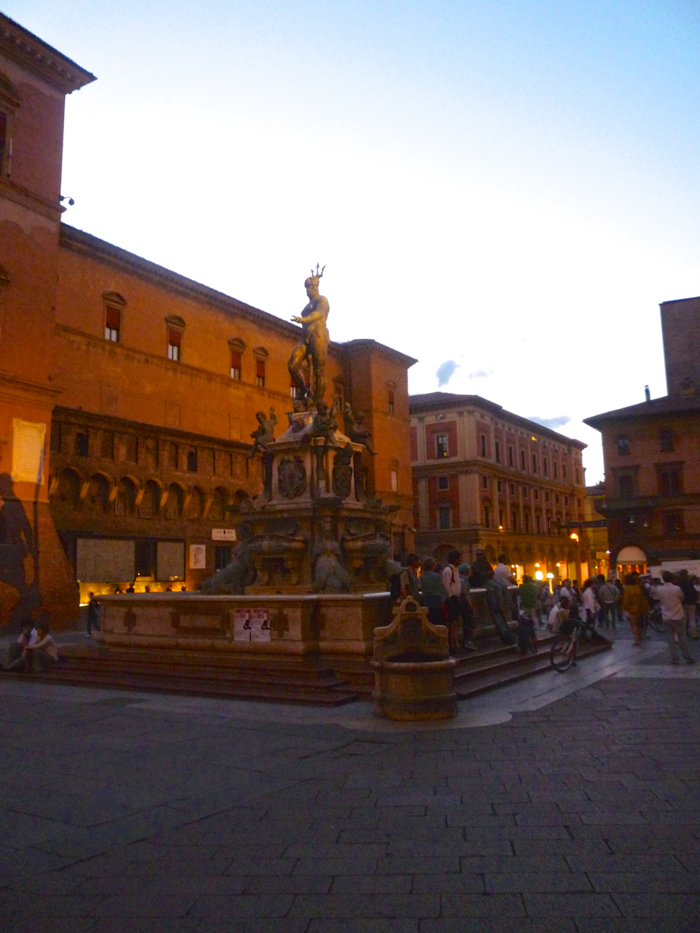
But what will be most immediately recognizable to foreign visitors to this region is it’s food. Some of the most prominent products and favorite Italian dishes hail from this region. Emilia Romagna is the only region in Italy where Parmigiano Reggiano cheese can be produced, as well as Prosciutto di Parma and the Balsamic Vinegar of Modena. It is the home of stuffed pastas, from tortollini to tortellini to capallacci. While in Bologna, enjoying a plate of homemade pasta topped with bolognese sauce is a must.
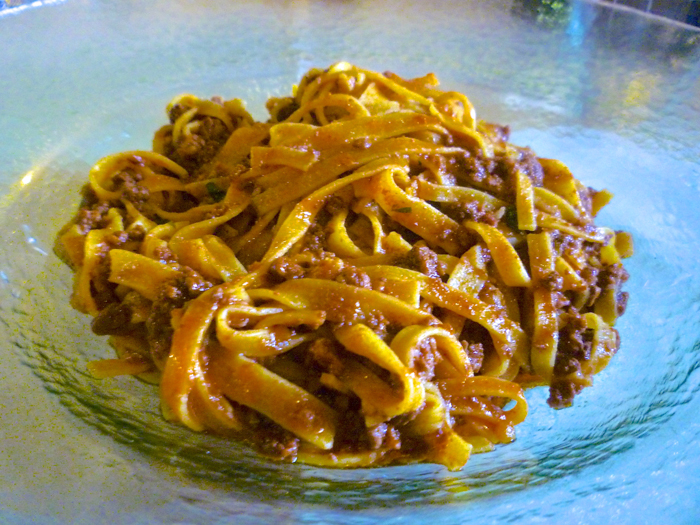
The fertile Po River Valley yields an exceptional array of crops, from rice for risottos, wheat for breads and pastas, to tomatoes, zucchini, cauliflower, beets, potatoes, peppers, onions, chard, squashes, cabbage, eggplant, green beans and asparagus, and fruits like peaches, pears and nectarines. Many of these appear in pasta sauces and vegetable dishes like grilled asparagus wrapped in prosciutto.
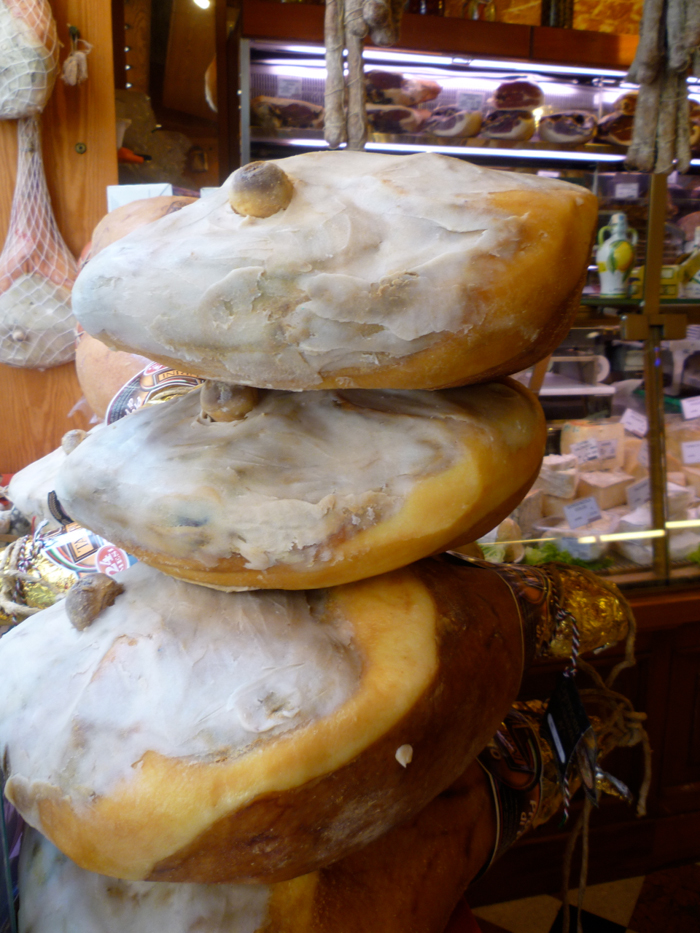
Pigs have been raised in this region since at least 1000 B.C., with today more than 2 million swine raised annually. The most famous of Italy’s prosciutto hams have been made in Parma, following a tradition handed down over hundreds of years. Here, the pigs feed on the whey left over from the production of Parmigiano cheese, which is said to make them fatter and sweeter. Coppa and pancetta are specialties of Piacenza in the north, just above Parma. A more delicate salami is the Mortadella di Bologna, the ‘original’ bologna
Parmigiano Reggiano is probably the unrivaled king of Italy cheeses. True Parmigiano cheese must be produced in the provinces of Parma, Reggio, and Emilia. Parmigiano-Reggiano is made from raw cow's milk, with each wheel requiring 170 gallons of milk. The whole milk of the morning milking is mixed with the naturally skimmed milk of the previous evening's milking. Traditionally, cows are fed only grass or hay, producing grass fed milk.
Another local product that shares in over 1000 years of tradition is the balsamic vinegar of Modena. The name comes from the Latin Balsamum, meaning a ‘balm’ or a restorative, and it was originally used for it’s curative properties. Supposedly, during the plague of 1630, the Duke of Modena carried an open jug of the vinegar in his carriage to ward off the disease. Today, it is world-renowned as a culinary condiment, highly valued by chefs, gourmets and home cooks alike.
These wonderful products of Emilia Romanga make their way into the many dishes this region is famous for:
Asparagi alla parmigiana, or con Prosciutto - asparagus, roasted or grilled, served with Parmigiano-Reggiano cheese or Prosciutto di Parma.
Gnocchi - unlike the dumplings seen in other regions of Italy, gnocchi here is a fried bread dough, often served with salami, prosciutto and/or cheese)
Scarpazzone or Erbazzone - a vegetable tart, with prosciutto and cheese, baked in the oven.
Piadina, crescentina, tigella - flatbread, shaped into a round circle, and grilled on hot coals. It can be stuffed with a wide variety of things - sausage, prosciutto, cheese, greens - as in piadina, or rubbed with lardo or fresh bacon, or served with cured meats and/or cheeses. The moniker tigella comes from the name of the clays disks between which it was traditionally cooked.
Anolini - round or half-moon shaped pasta stuffed with braised beef or breadcrumbs, eggs, nutmeg, and Parmigiano-Reggiano cheese, served in a broth, or brodo. Popular in Parma.
Cappellacci - large triangular shaped stuffed pasta, folded to resemble a hat, and filled with pumpkin, nutmeg and Parmigiano-Reggiano cheese, served with mixed meat sauces or butter, sage, and Parmigiano-Reggiano cheese. A specialty of Ferrara.
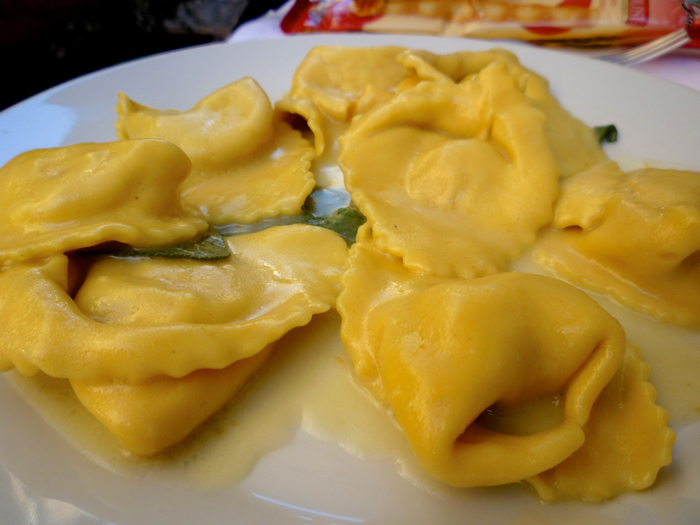
Cappelletti - another large triangular shaped, folded stuffed pasta, with different variations on meat fillings, depending upon the town you are in. Served in a broth.
Lasagne alla bolognese - baked pasta sheets layered with bolognese meat ragu, butter, Parmigiano-Reggiano cheese, and sometimes béchamel sauce. Also commonly prepared in Bologna with spinach flavored pasta sheets.
Passatelli - little dumplings of shredded spinach, cheese and egg dough, cooked in a broth. Passatelli alla bolognese uses breadcrumbs and bone marrow, rather than spinach.
Pasticcio - a round pastry pie filled with small macaroni, flavored with meat argue, mushrooms, and truffles in a béchamel sauce. The top crust is often decorated with leaf designs.
Tagliatelle alla bolognese - long ribbon shaped pasta, often golden in color. Legend has it that it was invented to honor the long flaxen hair of Lucrezia Borgia when she married Ferrara’s Duke of Este in 1487. Alla bolognese refers to the meat sauce, or ragu, that tops it - a blend of onions, carrots and celeery, with finely chopped mixed meats, milk, broth, and minimal tomato.
Tortelli, Tortellini, Tortelletti or Tortelloni - The premier speciality of Bologna is this stuffed pasta. The shape of this pasta supposedly resembles the female navel. Fillings range from ricotta, Parmigiano-Reggiano cheese, chard or sweet radicchio, prosciutto, veal, sausage, to pumpkin, often seasoned with nutmeg. To quote an article from the Gazzetta di Bologna over 100 years ago, “Tortellini is more essential than the sun for Sunday, or love for a woman.”
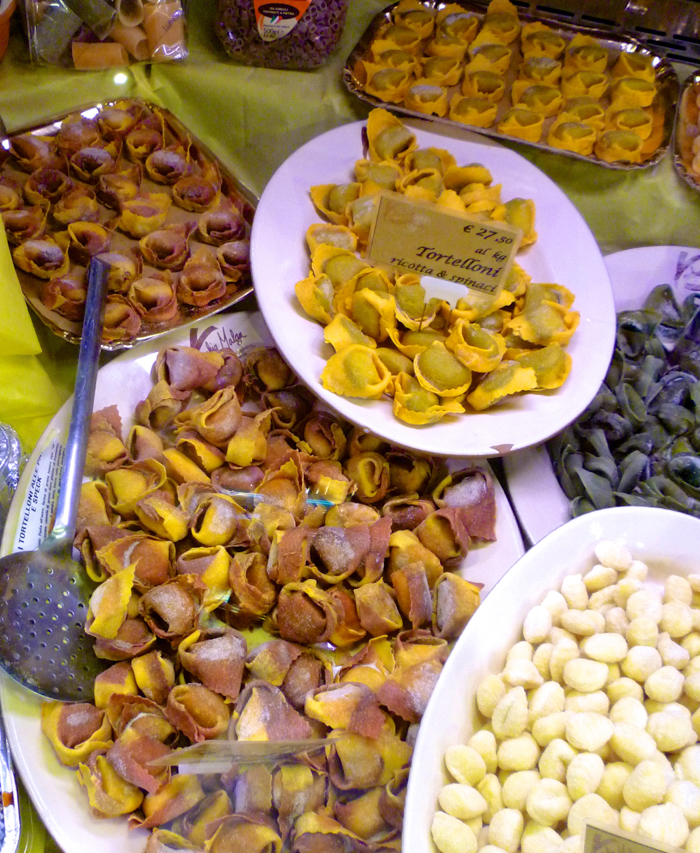
Anguilla alla Comacchio, or alla ravennate - the famous eels of Comacchio, skinned and cut into chunks, sautéed in butter and tomatoes. Also anguilla alls spiedo, with chunks of eel placed on a skewer, alternating with bay leaves.
Bollito misto - found all over Emilia-Romagna, mixed meats which can include beef, capon, veal, bone marrow, pork, zampone or cotechino, boiled together and served with a variety of side sauces, including salsa verde and mostarda.
Brodetto - The province of Ravanna borders the Adriatic, introducing many fish dishes into the cuisine of Emilia-Romagna. King of the fish dishes in this area is brodetto, a fish based soup. Made from a mixture of local seafood, with the favorite varieties and additional flavorings varying from town to town. These might include fish such as mackerel, sole, red mullet, and sardines to calamari, shrimp, and crayfish. Flavorings range from saffron, olive oil, wine, garlic, vinegar, herbs and tomato.
Costalette alla bolognese - originally made with both pork and veal, modern tastes now prefer the lighter version, with only veal. Similar to Rome’s saltimbocca, veal cutlets are breaded and fried, then topped with a slice of prosciutto, Parmigiano-Reggiano cheese, sometimes with white truffle, finished in a skillet with white wine and broth.
Cotechino - Modena favorite sausage
Salame da sugo - Ferrara’s favorite sausage, aged in marsala and red wines, and traditionally served with puréed pumpkin or potatoes.
Trippa alla bolognese - tripe cooked in broth with bacon, garlic, onion, finished with egg yolks and Parmigiano-Reggiano cheese.
Zampone - sausage stuffed pig’s feet from Modena.
Amaretti - macaroon made with almonds, exported in large quantities from Modena.
Benzone - S-shaped pastries, sprinkled with powdered sugar
Bonissima - a lemon cake filled with chopped walnuts, honey and rum
Bracciatelli - little doughnuts which street vendors used to sell at Easter threaded on canes
Castagnole - anise flavored fritters from Ravenna. Also Frittate dolci di pinoli, sweet pine-nut fitters.
Mandorlini del ponte - Ferrarese almond cookies from the almond town of Pontelagoscuro.
Pampepato di cioccolato - A very old Ferrara treat, a cake made with cocoa, pepper, spices, nuts, and candied fruits. Traditionally served at Christmas.
Panspeziale - A cake featured during the holiday season in Bologna, also called pan pepato. Flavored with nuts, dried fruits and candied citrus, boiled in wine and chocolate.
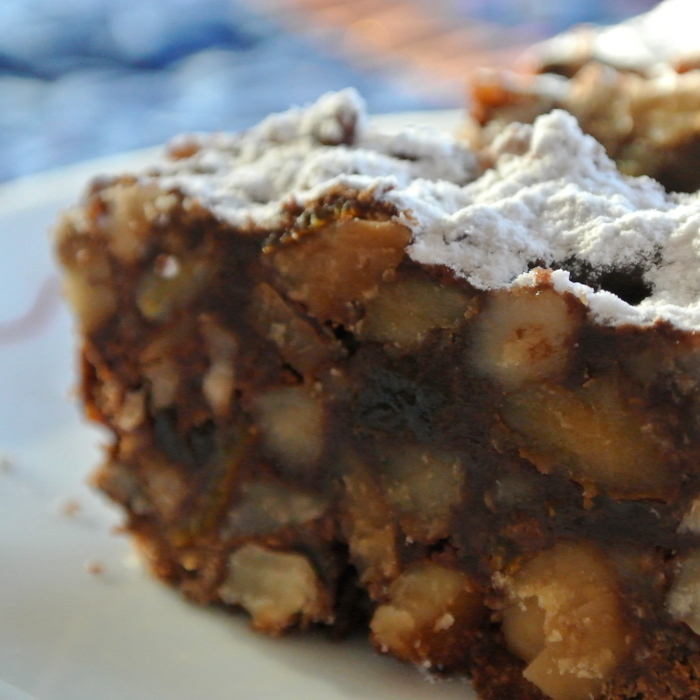
Pinza - a Bolognese tart filled with jam, various nuts and dried fruits, cocoa, and lemon zest
Spugnata - a pastry filled with honey, jam, chopped nuts, dried fruits, sometimes mostarda di frutta. Every community in the province of Parma has it’s own favorite version.
Torta di riso degli addobbi - a rice cake flavored with almonds, milk and sugar. Addobbi translate to “decorations” and original referred to the religious festivals themselves that required decorations. Today these are more rowdy celebrations, but “An addobbo with torts, like a political banquet without speeches, cannot exist.”
Torta di tagliatelle - sweetened Taglietelle dough crust, filled with butter, sugar, almonds, chocolate, and a favorite liqueur.
Torta nera - Names for its many dark ingredients - chocolate, coffee, creme di cacao, rum, and almonds mixed with butter, sugar and eggs.
Tuscany is considered by many to be the “Heart of Italy”, not simply due to it’s location near the geographic center of this diverse country. Here you will find Italian spoken in it’s truest form, and any fan of the Renaissance knows of the leading role that Florence and this region played in world history of that time. The food of this region is just as distinctive - robust flavors that don’t need fancy sauces or frills to distinguish it as notable. Simple, delicious dishes made with the freshest of local ingredients. Wonderfully simple and tasty cuisine.
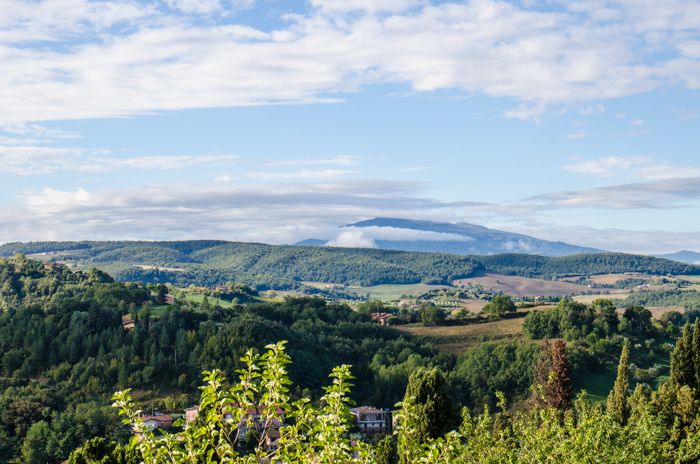
You’ll find many pasta dishes to enjoy in Tuscany, but not loaded down with red sauce. Homemade egg pasta such as papparadelle is served with meat sauces made with rabbit or cinghiale (wild boar). Grilled meats are quite common, with the famous bistecca alla florentina, a steak from the local Chianina or Maremmana cattle, normally cooked only to rare over a wood fire. Beans are ubiquitous, with Tuscans earning the nickname mangiafagioli, or ‘bean eaters’, and enjoyed on their own, in soups, salads, or as a side dish for meat.
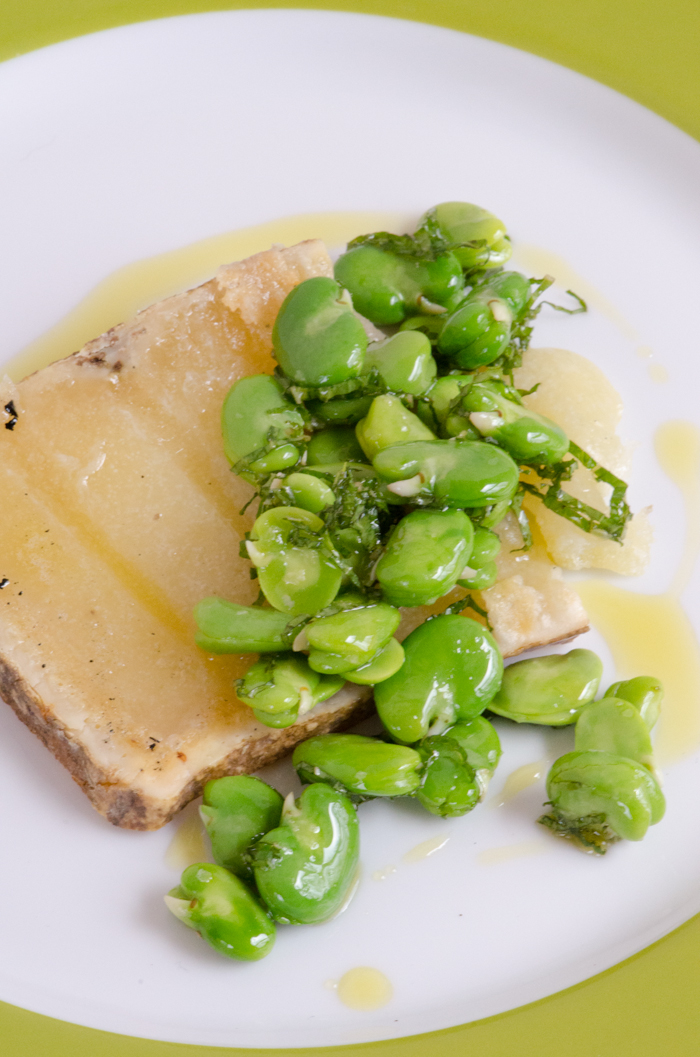
Minimal seasoning is used; salt, pepper, basil, rosemary, fennel, oregano are all used sparingly. I smile when I find a “Tuscan” style dish on a US menu with a complex array of ingredients. What is used liberally to flavor their dishes are their local products - wine and olive oil. Tuscans believe their olive oil is the finest in Italy, and are very particular about what type of olive oil to use when, and almost always only use extra vergine, except when frying. A real flavor treat is to enjoy a luxuriously simple pasta dish flavored with Tuscan truffles, both black and white truffles are found there.
The following is a list (by no means comprehensive!) of just a few of the wonderful dishes that make up the cuisine of Tuscany.
Salumi
Finocchiona—pork sausage studded with fennel seeds
Prosciutto di cinghiale—salt- and air-cured wild boar
Salame toscano—pork sausage studded with pepper and cubes of fat
Salsicce fresche—fresh sausage of pork or wild boar
Sopprassatta—head cheese or cooked sausage made from pig’s head, with spices and lemon peel
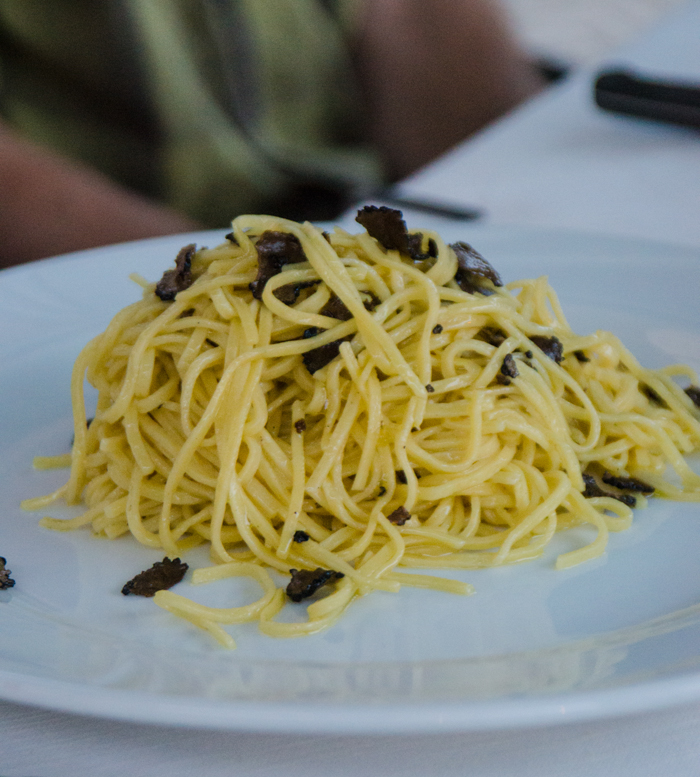
Antipasto
Crostini—traditional minced liver canapés
Crostini di milza—canapés of minced sautéed spleen
Fettunta or Bruschetta—slab of toasted country bread rubbed with garlic and dipped in extra virgin olive oil, sprinkled with salt and pepper
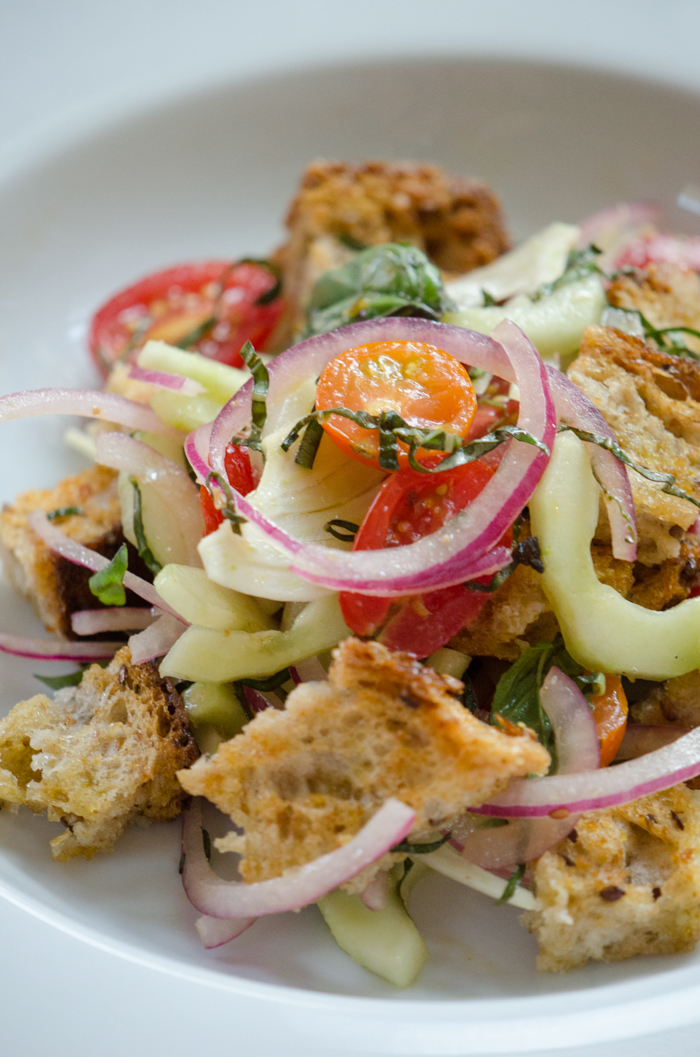
Primo
Acquacotta—vegetable mushroom soup served over toasted bread and topped with a poached egg
Cacciucco—coastal fish stew with tomatoes, chili pepper and red wine
Carbaccia—onion soup
Cavolo con le fette—cooked black cabbage on garlic bread, moistened with cabbage broth and liberally dressed with olive oil
Garmugia—springtime vegetable soup made with fava beans, peas, artichokes, asparagus tips and bacon
Gnocchi di ricotta—dumplings filled with ricotta and spinach
Infarinata—vegetable soup thickened with cornmeal
Minestra di farro—spelt and bean soup
Panzanella—summer salad of tomatoes, basil, cucumber, onion and bread dressed with olive oil
Pappa col pomodoro—tomato soup thickened with bread, drizzled with olive oil at the table
Pappardelle sulla leper—homemade egg pasta noodles with a wild rabbit sauce
Penne strascicate—quill-shaped pasta “dragged through” a meat sauce
Pici—hand-rolled egg pasta that looks like short, thick spaghetti
Ribollita—hearty winter vegetable soup thickened with bread and drizzled with olive oil at the table
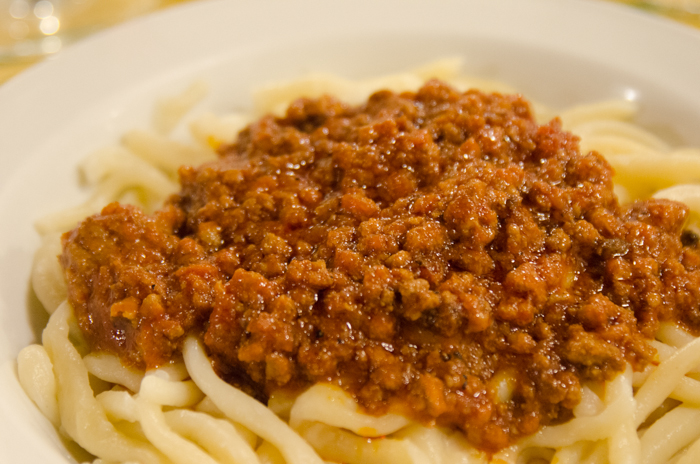
Formaggio
Pecorino—fresh or aged sheep’s milk cheese
Raveggiolo—soft, fresh sheep’s milk whey cheese
Ricotta—soft, fresh, milk, made from whey
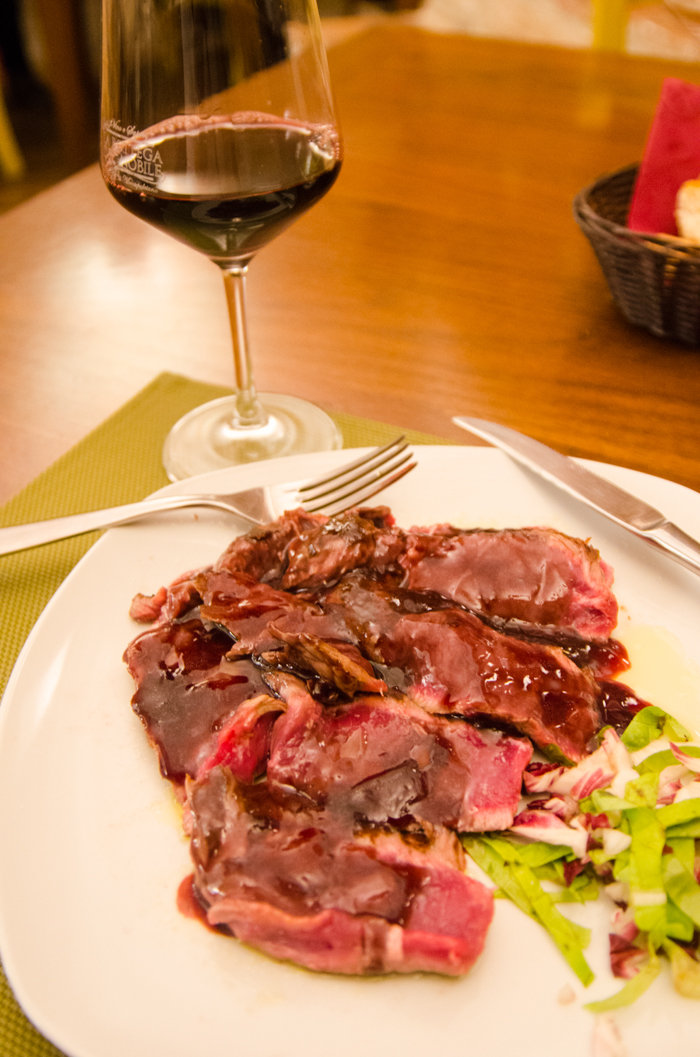
Secondo
Arista—roast pork loin with garlic and rosemary
Asparagi all fiorentina—asparagus topped with melted butter, a fried egg, and cheese
Baccalà alla livornese—salt cod cooked with garlic, tomatoes and parsley
Bistecca alla fiorentina—T-bone steak, charcoal-grilled
Cibreo—stew of chicken livers, unlaid eggs and cockscomb
Cieche alla pisana—tiny baby eels cooked with garlic and tomatoes, served with Parmesan cheese
Fritto misto—mixed fried foods, usually chicken, rabbit or lamb chops, and vegetables
Lombatina—veal chop, usually grilled
Peposo—peppery beef stew
Pollo alla diavola—chickened flatten with a brick, grilled with herbs
Scottiglia—mixed stew of veal, game, and poultry, cooked with white wine and tomatoes
Spiedini di maiale—pork loin cubes and pork liver spiced with fennel, skewered with bread and bay leaves, and grilled or spit-roasted
Stracotto—pot roast
Tonno con fagioli—tuna served with white beans and raw onion
Totani all’inzimino—cuttlefish cooked with Swiss chard and tomatoes
Triglie livornese—red mullet cooked with tomatoes, garlic and parsley
Trippa alla fiorentina—tripe cooked with tomatoes, served with Parmesan cheese
Contorno
Fagioli al fiasco—boiled white beans
Fagioli all’olio—white beans served with oil
Fagioli all’uccelletto—white beans cooked with tomatoes, garlic and sage
Frittata di carciofi—pan-fried artichoke flan
Pinzimonio—raw seasonal vegetables dipped in extra virgin olive oil, salt and pepper
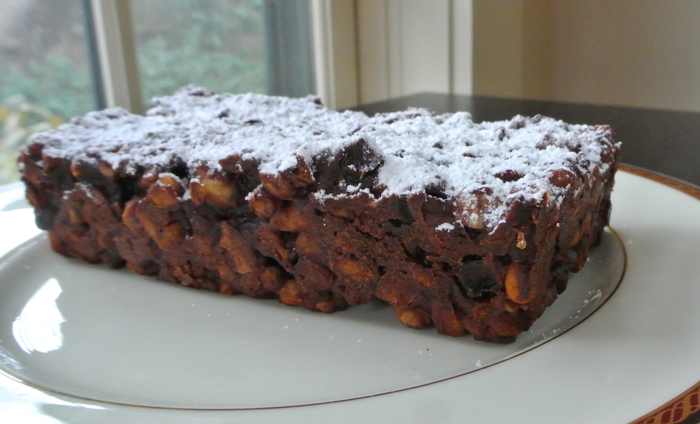
Dolce
Biscottini di Prato or cantucci—dried almond cookies, served with dessert wine
Bongo— filled cream puffs with chocolate sauce
Brigidini—anise wafer cookies
Buccellato—simple anise raisin cake
Castagnaccio—baked unleavened chestnut-flour cake with raisins, walnuts and rosemary
Panpepato - spicy fruit cake with nuts, dried fruit and dark chocolate


